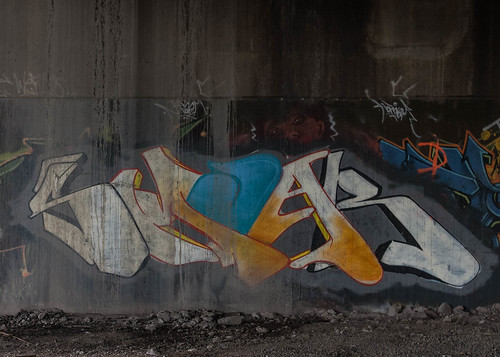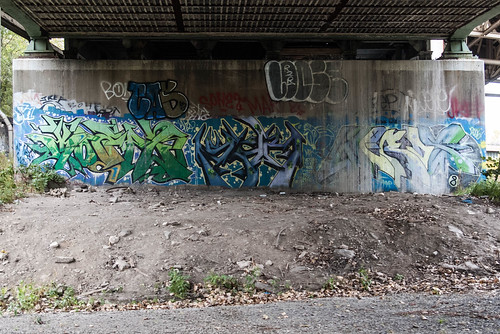Graffiti is a curious activity. Existing at the edge of the law, it has to make its own laws. Perhaps the most important of those govern wall protocol: going over some other writer's work. The basic rule is simple: Always improve the wall. That means that, if you go over someone else's work, you should put something better in the spot. If you don't, that's taken as an insult and can lead to war – which happens mostly on walls (see Tales Told on a Wall, A Year in the Life), but can also lead to physical violence among writers should the combatants happen to meet face-to-face.
So, I took this flick on Oct 28, 2006:
That's on one of the stanchions supporting the 14th Street viaduct in Jersey City, and it's one of the first walls I saw when I got serious about flicking graffiti. That boy in the mushroom cloud, by Komar (flanked by Distort on the left and Then on the right), told me there's something serious going on here. It's not just a bunch of kids breaking the law. Here's the middle of the same wall on Oct 26, 2014:
The Komar is mostly gone, though you can see a bit of it peaking over the SMEAR throwie. That's definitely NOT a step up. But there may be mitigating circumstances. There's been repair work on the viaduct recently and you can see that a lot of dust and slurry has leaked down over the wall, obscuring the graffiti. It's possible that the Komar was obliterated before SMEAR went over.
This wall is a couple stations south of the SMEAR wall. I took this photo on Nov 28, 2006:
This wall has been untouched in the years I've been photographing it. That, of course, is a sign of respect, but it doesn't hurt that this wall is relatively exposed to view, which makes writing there just a bit more dangerous. And when I say "relatively" I mean just that. You can't see this area if you're just driving along in your car or in a bus because it doesn't face a roadway, which means no sidewalks either. But it does face an active railroad line, which means that railroad cops are back there. That's the danger. But they don't generally patrol on foot; they mostly sit in their SUVs and watch. So they can only see some of the walls, like this one, but not that previous one.
Still, things do not look good. Here's the wall on Oct 26, 2014:
You can see slurry's been leaking down on the right. How long before it gets bad enough that someone will go over it?




No comments:
Post a Comment